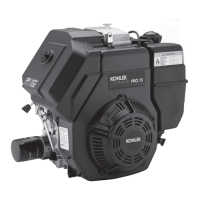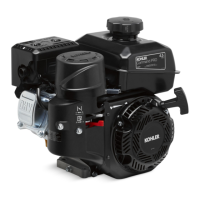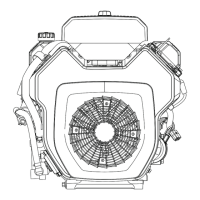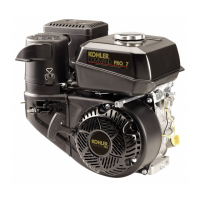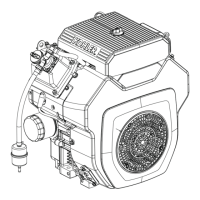3.2
Section 3
Troubleshooting
Engine Overheats
1. Air intake/grass screen, cooling fi ns, or cooling
shrouds clogged.
2. Excessive engine load.
3. Low crankcase oil level.
4. High crankcase oil level.
5. Faulty carburetor.
6. Lean fuel mixture.
Engine Knocks
1. Excessive engine load.
2. Low crankcase oil level.
3. Old or improper fuel.
4. Internal wear or damage.
5. Poor quality fuel.
6. Incorrect grade of oil.
Engine Loses Power
1. Low crankcase oil level.
2. High crankcase oil level.
3. Dirty air cleaner element.
4. Dirt or water in the fuel system.
5. Excessive engine load.
6. Engine overheated.
7. Faulty spark plug.
8. Low compression.
9. Exhaust restriction.
10. Incorrect governor se ing.
Engine Uses Excessive Amount of Oil
1. Incorrect oil viscosity/type.
2. Clogged, broken or inoperative crankcase
breather.
3. Worn or broken piston rings.
4. Worn cylinder bore.
5. Worn valve stems/valve guides.
6. Crankcase overfi lled.
7. Blown head gasket/overheated.
Oil Leaks from Oil Seals, Gaskets
1. Clogged, broken or inoperative crankcase
breather.
2. Loose or improperly torqued fasteners.
3. Piston blowby, or leaky valves.
4. Restricted exhaust.
External Engine Inspection
Before cleaning or disassembling the engine, make a
thorough inspection of its external appearance and
condition. This inspection can give clues to what
might be found inside the engine (and the cause)
when it is disassembled.
• Check for buildup of dirt and debris on the
crankcase, cooling fi ns, grass screen, and other
external surfaces. Dirt or debris on these areas
are causes of higher operating temperatures and
overheating.
• Check for obvious fuel and oil leaks, and
damaged components. Excessive oil leakage can
indicate a clogged breather, worn/damaged seals
and gaskets, or loose or improperly-torqued
fasteners.
• Check the air cleaner cover and base for damage
or indications of improper fi t and seal.
• Check the air cleaner element. Look for holes,
tears, cracked or damaged sealing surfaces, or
other damage that could allow unfi ltered air into
the engine. Also note if the element is dirty or
clogged. These could indicate that the engine has
been under serviced.
• Check the carburetor throat for dirt. Dirt in the
throat is further indication that the air cleaner is
not functioning properly.
• Check the oil level. Note if the oil level is within
the operating range on the dipstick, or if it is low
or overfi lled.
• Check the condition of the oil. Drain the oil into
a container - the oil should fl ow freely. Check for
metal chips and other foreign particles.
Sludge is a natural by-product of combustion; a
small accumulation is normal. Excessive sludge
formation could indicate overrich carburetion,
weak ignition, overextended oil change intervals
or wrong weight or type of oil was used, to name
a few.
NOTE: It is good practice to drain oil at a
location away from the workbench. Be
sure to allow ample time for complete
drainage.
